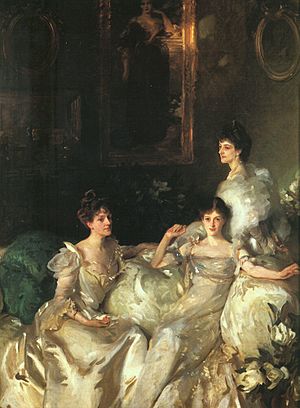The Souls facts for kids
The Souls was a special group of friends in the United Kingdom. They were active from 1885 until around 1900. This group included many important politicians and thinkers of that time. The Souls were most active in the early 1890s. They slowly faded away as a distinct group by 1900.
Contents
How the Souls Group Started
This group formed because social life was a bit tense. This tension came from big political arguments about Irish Home Rule in 1886. People were fighting about whether Ireland should have its own government. Many social groups were divided by these arguments. People wanted a place to meet and talk without fighting about politics.
Wilfrid Scawen Blunt, one of the members, explained what the Souls wanted. They wanted to avoid the usual social activities like racing and card games. Instead, they looked for excitement in deeper conversations and feelings. He said they were "bent on pleasure, but pleasure of a superior kind."
The name "The Souls" reportedly came from Lord Charles Beresford. He said, "You all sit and talk about each other's souls—I shall call you the 'Souls'."
Who Were the Souls?
The original Souls group included many interesting people. It's important to know that many women on this list were members because of their own talents, even before they married other members.
The Balfours
- Arthur Balfour (1848–1930): He later became the Prime Minister of the United Kingdom from 1902 to 1905.
- Edith Sophy Balfour (1865–1948): She was a writer and a playwright. She also worked to help people during World War I. In 1917, she was one of the first people to receive the Order of the British Empire award.
The Wyndhams
The Wyndham family was a big part of The Souls. This included Percy Wyndham, his wife Madeline, their two sons, and three daughters. The children's spouses were also members. Percy Wyndham asked John Singer Sargent to paint his daughters. This painting is now very famous and is called The Wyndham Sisters.
- Hon. Percy Scawen Wyndham (1835–1911): He was a soldier and a politician. He was also a collector and a thinker.
- Madeline Caroline Frances Eden Campbell Wyndham (1846–1920): She married Percy Wyndham in 1860.
- George Wyndham (1863–1913): He was the Wyndhams' older son. He served in the army and later became a politician. He worked to help farmers in Ireland buy their own land.
- Guy Percy Wyndham (1865–1941): He was the Wyndhams' second son and an army officer.
- Madeline Pamela Constance Blanche Wyndham (1869–1941): She was the Wyndhams' second daughter. She married an army officer named Charles Adeane.
- Pamela Adelaide Genevieve Wyndham Glenconner Grey (1871–1928): She was the youngest Wyndham child. She was an author and editor. She wrote about her son, a war poet, who died in 1916. She was friends with famous writers like Henry James and Oscar Wilde.
- Mary Constance Charteris, Lady Elcho (1883–1914): She was the oldest daughter of Percy and Madeline Wyndham. She married Hugo Charteris, Lord Elcho. Two of her sons were killed in World War I.
The Custs
- Henry "Harry" Cust (1861–1917): He was a politician and known for being a great talker. He also edited a newspaper called the Pall Mall Gazette. He made it very popular by having famous writers like Rudyard Kipling contribute. During World War I, he worked on spreading positive messages for the British government.
- Emmeline 'Nina' Mary Elizabeth Welby (1867–1955): She was a writer, editor, and sculptor. She married Harry Cust in 1893. She helped him with his work, including his efforts during the war.
The Grenfells
- William Grenfell, 1st Baron Desborough (1855–1945): He was a British athlete, sportsman, and politician. He held many important public roles. He was also involved in planning the Desborough Cut, a special channel on the River Thames.
- Ethel 'Ettie' Grenfell, née Fane, Lady Desborough (1867–1952): She was a well-known hostess. Many famous people visited her home, including Winston Churchill. She was a close friend to six Prime Ministers. The Grenfells faced great sadness, losing all three of their sons. Two died in World War I, and one died in a car accident.
The Windsor-Clives
- Robert Windsor-Clive, 1st Earl of Plymouth (1857–1923): He was a politician and the first president of the London Society.
- Alberta Victoria Sarah Caroline Windsor-Clive, née Paget, Countess of Plymouth (1863–1944): She was his wife.
Other Members
- George Curzon, 1st Marquess Curzon of Kedleston (1859–1925): He was the Viceroy of India from 1899 to 1905.
- Margot Asquith, née Tennant (1864–1945): She was a well-known socialite and writer. She married H. H. Asquith, who became Prime Minister.
- Laura Tennant (1882–1886): Margot's sister. She married Alfred Lyttelton and sadly died a year later.
- Lucy Graham Smith (1860–1942): Another of Margot's sisters.
- St. John Brodrick (1856–1942): He was a politician who held many important government jobs.
- Hugo Richard Charteris, Lord Elcho (1857–1937): He was a Scottish politician. He married Mary Constance Wyndham.
- Alfred Lyttelton (1857–1913): He was a talented athlete in both football and cricket. He also became a lawyer and a politician. He served as Secretary of State for the Colonies.
- Henry White (1850–1927): He was a diplomat from the United States. His wife, Margaret Stuyvesant Rutherfurd 'Daisey' White, was also a member.
- Violet Manners, Duchess of Rutland (1856–1937).
The Coterie: The Next Generation
The Coterie is often seen as the second generation of The Souls. This was another famous group of smart people. It included aristocrats, politicians, and art lovers. Many of them sadly died in the First World War.
Some members of The Coterie were children of the original Souls. For example, Lady Diana Manners was a member. She later married Duff Cooper, who became a British Ambassador. Raymond Asquith, the oldest son of Prime Minister H. H. Asquith, was also in The Coterie. He was killed during the Battle of the Somme.


